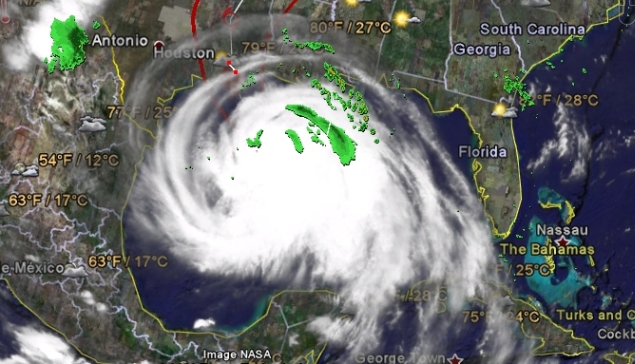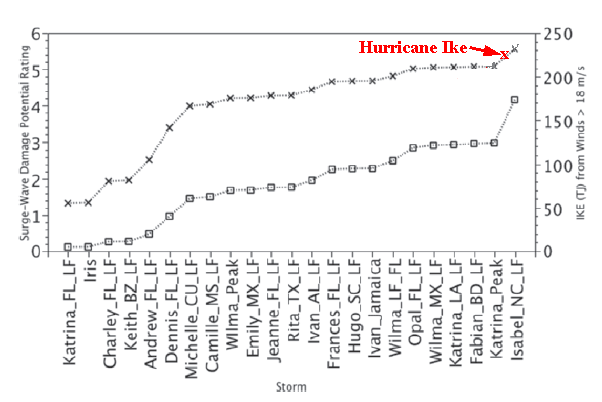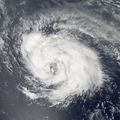Ide jön minden, ami Ike-kal kapcsolatos.
ITT NÉZHETITEK RENGETEG TÉVÉCSATORNÁN EGYSZERRE!
A modellek és a Google Earth felhasználásával Ike középpontja 7 km-re halad el Galvestontól és 24 km-re Houston belvárosától. A középponttól számított 195 km-es sugarú körben hurrikán, 450 km-es sugarú körben trópusi vihar van jelenleg.

Nem a Saffir-Simpson skálát érdemes nézni, az "csak" a felszíni szélerősséget mutatja. A mi számunkra fontosabb most a kinetikus energia modell, ami azt mutatja, hogy mennyi vizet mozgat meg Ike.
Ezen az úgy nevezett IKE (Integrated Kinetic Energy) modell katrinát 5.1-es értékkel látta el. Ike jelenleg 5.2-es értékkel bít (6.0 a maximum). Itt a modell rövid leírása:
The total energy of Ike
The amount of water Ike has put in motion is about 10% greater than what Katrina did, and thus we can expect Ike's storm surge damage will be similar to or greater than Katrina's. The way we can estimate this damage potential is to compute the total energy of Ike's surface winds (kinetic energy). To do this, we must look at how strong the winds are, and factor in the areal coverage of these winds. Thus, we compute the Integrated Kinetic Energy (IKE) by squaring the velocity of the wind and summing over all regions of the hurricane with tropical storm force winds or higher. This "Integrated Kinetic Energy" was recently proposed by Dr. Mark Powell of NOAA's Hurricane Research Division as a better measure of the destructive power of a hurricane's storm surge than the usual Category 1-5 Saffir-Simpson scale. For example, Hurricane Katrina hit Mississippi as a strong Category 3 hurricane, yet its storm surge was more characteristic of a Category 5 storm. Dr. Powell came up with a new scale to rate potential storm surge damage based on IKE (not to be confused with Hurricane Ike!) The new scale ranges from 1-6. Katrina and Wilma at their peaks both earned a 5.1 on this scale (Figure 2). At 12:30pm EDT today, Ike earned a 5.2 on this scale
És itt egy kép:

A lényeget mindjárt lefordítom, egyelőre álljon itt az eredeti szöveg:
Ike's waves
All this energy is also going into the waves in the Gulf of Mexico, and the offshore oil rigs can expect to receive a terrific battering. At 1:50pm CDT, waves at the buoy 42001 180nm south of Louisiana peaked at 30 feet. NHC is predicting Ike's waves will peak at 50 feet (15 meters) in the northern Gulf on Friday. For comparison, Hurricane Ivan of 2004 generated 27 meter (89 foot) high waves in the Gulf of Mexico. The oil companies spent hundreds of millions of dollars upgrading their oil rigs in the Gulf in the wake of the destruction wrought by Ivan and Katrina and Rita, and I'm not anticipating severe damage to the rigs from Ike's 50-foot waves.
Ike's storm surge
According to the NOAA tide gauges, the storm tides along the Mississippi coast have peaked at 4 feet above normal, and are currently running 5 feet above normal on the east side of New Orleans at Shell Beach in Lake Borgne. A storm surge of 5.9 feet was observed in New Orleans' Industrial Canal at 10:45 am CDT, and 5.75 feet in Waveland, Mississippi. Coastal Alabama is reporting a 4-6 foot storm surge, with 10-15 foot waves. Considering the center of Ike is over 250 miles south of these locations, it is not hard to imagine that Texas will get a 15-20 foot storm surge, even if Ike does not strengthen.
Ike will probably inundate a 250-mile stretch of Texas coast from Port O'Connor to the Louisiana border with a 10-15 foot storm surge. This will occur even if Ike is a Category 1 storm at landfall. If Ike is a Category 3+ hurricane at landfall, surges of 20+ feet are possible. The latest experimental storm surge forecast From NOAA's SLOSH model (Figure 1) shows a 10% chance that Ike's storm surge will exceed 18-21 feet at Galveston. The Galveston sea wall is 17 feet high, so it may get overtopped. At noon today, a mandatory evacuation of the entire island was ordered in case this worst-case scenario is realized. The official NHC forecast is calling for maximum storm surge heights of 20 feet.
A Saffir-Simpson skála a felszíni szélerősséget méri, és annak alapján osztályozza a hurrikánokat. Maga a romboló energia a szélsebesség négyzetével arányos. Ike-ra egyelőre az az előrejelzés, hogy 115 mph-val fog földet érni. Lehet, hogy többel.
Ez 185 km/h szélerősséget jelent. Nálunk (Magyarországon) 90 km/h már hatalmas viharnak minősül. Ez ugyanis az 'állandó szélerő' (sustained winds), amit nagyobb 'széllőkések' (gusts) kísérnek. Na most. Amikor nálunk 90 km/h vihar van, 110 km/h széllőkésekkel, akkor hatalmasak a viharkárok. Az előző, négyzetes összefüggést figyelembe véve: kétszer akkora szél négyszer akkora energiát (romboló hatást) fejt ki. Magyarul: ha mondjuk egy házat 150 km/h szélerősségre és 200 km/h széllökésekre terveznek, akkor az 'egyben marad' akkor, ha egy hurrikán 90 mph 'sustained wind'-del ér partot (Cat1). Viszont összedől, ha a szélerősség eléri a 120 mph-t.
Hasonlóan van ez az infrastruktúrával is. Az alábbi oldalon lehet erről tájékozódni:
Beteszek 4 képet is. Igaz, hogy ez tornádó, nem hurrikán, de a hurrikán közepe (ha lesz a végére 'szem') hatásában nagyon hasonlít egy tornádóhoz.




Több kép elérhető ITT: http://www.ultimatechase.com/chase_accounts/Greensburg_Tornado_Damage_Survey.htm
ITT NÉZHETITEK RENGETEG TÉVÉCSATORNÁN EGYSZERRE!






Utolsó kommentek